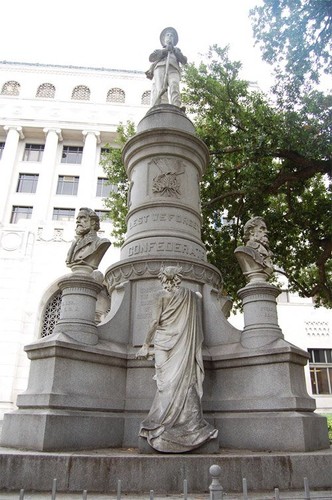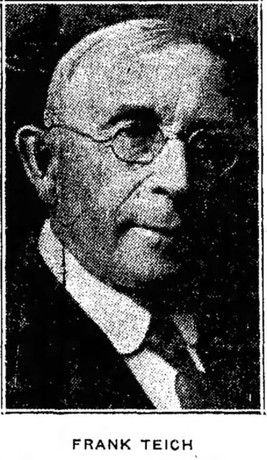Caddo Parish Confederate Monument
Introduction
Text-to-speech Audio
Images
This monument erected by the UDC in 1905 is scheduled for removal

Frank Teich, a German immigrant to Texas who found business success sculpting Confederate monuments

Backstory and Context
Text-to-speech Audio
Louisiana seceded from the United States and fought with the Confederacy during the Civil War. Shreveport was a major departmental and logistical hub for regional Confederate forces and served as the capital of Louisiana during the latter part of the Civil War. Several major battles occurred near Shreveport, including the 1864 Battles of Mansfield and Pleasant Hill.
In 1902, local women of the Shreveport Chapter of the United Daughters of the Confederacy (UDC) began discussing the possibility of erecting a monument to Louisiana's Confederate veterans. As the years rolled on, more Civil War veterans passed away. The UDC sought to honor these veterans while time remained, while also leaving a monument to carry their legacy into the future.
Yet historians have shown that the UDC and other Southern veterans' organizations often promoted the "Lost Cause," a reference to the idea that the Southern cause of defending antebellum culture and institutions, including slavery, was just. These groups deny the connection between slavery and the Civil War, lionize Confederate officers, soldiers, and women, and downplay the nature of Confederate military defeat. These Lost Cause tenets are evident in both the monument itself and its dedication.
The UDC, with the help of the local Caddo Parish Police Jury, managed to raise $10,000 and contracted sculptor Frank Teich to craft the monument. An exceptional sculptor, Teich developed a thriving business in Confederate monuments. He crafted many (if not most) of the Confederate monuments in Arkansas, Louisiana, and Texas, and as scholars Cynthia Mills and Pamela Simpson noted, he was one of six "key image makes of Confederate Memory."[2]
The 30-foot tall, Texas granite monument Teich sculpted was certainly grand and compares favorably with other major Confederate monuments in New Orleans. Atop a central pillar stands a Confederate private standing vigil; inscribed on the pillar reads "Lest We Forget" and "Confederate." At the base of the pillar stand a representation of Clio, the female muse of history in Greek lore. Surrounding the pillar are busts of four prominent Confederate leaders: Generals Robert E. Lee and Thomas "Stonewall" Jackson (arguably the Confederacy's most well-known military leaders), General P.G.T. Beauregard (Louisiana's most notable general), and General and Governor Henry Watkins Allen (Louisiana's wartime governor).
As was common across the post-war South, the monument's dedication in the spring of 1906 proved a major civic affair. Thousands attended the event, including hundreds of Confederate veterans. The keynote speaker was Methodist Reverend Dr. W.T. Bolling whose speech reflected Lost Cause denial of slavery as the war's cause:
"The men who went forth to battle under this banner were not actuated by hate, by desire for conquest, or to maintain the institution of slavery, but battled for what they believed to be a great fundamental doctrine, a foundation principle in a government founded upon the consent of the governed."[2]
In 1936, the 46th reunion of Confederate veterans was held in Shreveport, and a tablet was added to the foot of Shreveport's Confederate monument reading, "Louisiana and Shreveport's tribute of honor and respect, memorializing the deeds and valor of the men who so gallantly, nobly, and conscientiously defended the cause of 1861-65."[2]
In recent years, more and more Americans view this kind of celebratory monument and others that attempt to lionize Confederate leaders as remnants of white supremacy. Supporters of the monument said it symbolizes Southern heritage and argue that removing the monument is tantamount to deleting history. There have been calls for the monument's removal from courthouse grounds. As local activist Pastor Linus Mayes noted, "The statue, itself, brings with it, a bit of hatred, white supremacy, systemic racism...This is what we see as African-Americans when we get ready to go into the courthouse."[4]
On October 20, 2017, the Caddo Parish Commissioners voted to remove the controversial Confederate monument from the Caddo Parish Courthouse. The 7-5 decision came after nine months of community meetings and heated debate that continued during the commission meeting. Members of the United Daughters of the Confederacy, the women's organization that erected the monument in the early 1900s, hopes that a federal judge will block removal. The prospect of a Confederate heritage organization requesting federal assistance, like the monument itself, demonstrates that historical perspectives change over time. In July 2018, a federal judge dismissed the UDC's lawsuit and supported the local government's decision to remove the monument.
Following extensive legal battles and negotiations, in the summer of 2020, Caddo Parish and the UDC finally agreed to relocate the monument to private land near a Civil War battlefield in neighboring DeSoto Parish. The removal timeline has yet to be determined.
Sources
1. Nick Wooten. "Judge: Caddo Confederate monument can be moved." July 25, 2018. Shreveport Times. Web. Accessed September 16, 2018. https://www.shreveporttimes.com/story/news/2018/07/25/judge-says-caddo-Confederate-monument-can-moved/838305002/.
2. "Caddo Parish Confederate Monument." 2013. National Register of Historic Places Registration Form. National Park Service, U.S. Dept. of the Interior. Web. Accessed September 13, 2020. https://www.nps.gov/nr/feature/places/pdfs/13001124.pdf
3. Emily Enfinger and Scott Ferrell. "Caddo Parish, Daughters of Confederacy reach agreement to move monument." July 21, 2020. Shreveport Times. Web. Accessed September 14, 2020. https://www.shreveporttimes.com/story/news/local/2020/07/20/agreement-reached-move-caddo-parish-confederate-monument/5473757002/
4. Destinee Patterson. "Caddo Parish Confederate monument to be moved to DeSoto Parish." September 12, 2020. KSLA12 News. Web. Accessed September 14, 2020. https://www.ksla.com/2020/09/12/caddo-parish-confederate-monument-be-moved-desoto-parish/
5. Susan Teich. "Frank Teich." Handbook of Texas Online. Web. Accessed September 14, 2020. https://www.tshaonline.org/handbook/entries/teich-frank
Texas State Historical Association, Handbook of Texas, https://www.tshaonline.org/handbook/entries/teich-frank
